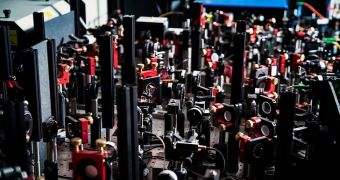Teleportation is still an impossible feat, something that you can only find in science and/or fantasy fiction, but that doesn't mean that scientists aren't trying to make it possible anyway. In fact, they have, in a way, managed to pull it off already.
You may have heard of quantum entanglement, the physical phenomenon where pairs or groups of particles are generated or interact in ways such that the quantum state of each particle cannot be described independently.
Basically, quantum particles behave the same way even when they are light years apart. Obviously, this can't exactly be observed, but it's not like huge distances are a must.
Short-distance quantum mechanics have been a subject of research for pretty much every physics university in the world for many years.
And it so happens that physicists at the Kavli Institute of Nanoscience at the Delft University of Technology, the Netherlands, were able to achieve an important milestone.
What they did was teleport information between two quantum bits separated by a distance of 10 feet, or 3 meters if you prefer that measurement system.
“Quantum information” is another term for the spin state of an electron (at least in this case) from one place to another without moving through the physical matter in between.
It's important to realize that quantum bits are a lot more complex than basic units of information in computing.
Otherwise known as binary code, it only comes in 0 or 1 states, or true and false. Qubits, however, can describe a whole bunch of values at once.
Now, the next step is increasing the distance of the teleportation. Once achieved, it will confirm Bell's theorem, proposed in 1964, which says that it should be possible for particles connected via quantum entanglement to communicate information faster than the speed of light.
It's a bigger deal than you might think, because a confirmation would prove Einstein wrong – he said it was impossible for particles separated by light years to remain connected this way (he called it “spooky action at a distance”).
All in all, we're still centuries away from transmaterialisers like the teleporters in Stargate and Star Trek, but we've made the first step towards them. Sure, previously, quantum teleportation was achieved, but only once in 100 attempts or so (2009, University of Maryland). Now, it's 100% accurate, or so the Netherlands team claims.
Their method involved producing qubits using electrons trapped in diamonds at extremely low temperatures (the diamonds are “miniprisons” in which the electrons were held).

 14 DAY TRIAL //
14 DAY TRIAL //